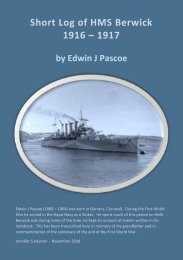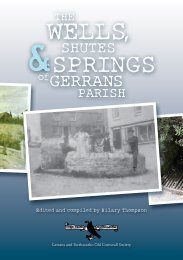2021-04 Newsletter
You also want an ePaper? Increase the reach of your titles
YUMPU automatically turns print PDFs into web optimized ePapers that Google loves.
News
Newsletter – April 2021
Now we are in Spring, and indeed looking forward to Summer. At the same time the Government’s
Roadmap out of Lockdown is beginning to open up opportunities.
We are now in the process of preparing a programme of events for the remainder of the year. Please
let us know if you have any suggestions. We will be prioritising outdoor activities in line with
Government guidance. Amongst those activities under consideration will be a visit to Castle-an-Dinas
and also walks to Carne Beacon and Dingerein. We hope to let you have details of these very soon.
Work on various projects continues apace. Additional information can be found on our website, Twitter
and Facebook.
Local History – Giant’s Quoit
The Giant’s Quoit was an important local rock feature situated near Carne. It was on a significant rock
outcrop which possible gave rise to the name of the settlement itself.
Figure 1 1879 Map Showing Location of Giant's Quoit
It is unsure whether the rock feature was geological or archaeological in nature. However, it was widely
known and gave rise to local legends and stories. There was a nationwide outcry when it was destroyed
by quarrying activity in 1907. An information sheet has now been put together which explores the
“Quoit’s” history.
Lost Locations – Velenoweth Corner
Kowethas Kernow Goth - Gerens ha Porthskathow
As the nature of our community changes, there is the potential for local knowledge to be lost. This
section seeks to highlight local names for places and encourage their use.
The
sharp
bend
in the
road at
the
end of
Clifton
Figure 2 1906 O.S. Six Inch Map Showing Velenoweth Corner
Terrace, Portscatho is known locally as Velenoweth Corner (aka Velanoweth).
Figure 3 2016 Velenoweth Corner ©Google
The name Vellanoweth was originally a Cornish language place-name, and places with this name exist
in Constantine, Ludgvan and St. Agnes parishes. In all of these cases the historic spellings show that the
names originally began with an “m” and only changed to a “v” much later.
The etymology of this name is <melin> ‘mill’ + <nowedh> ‘new’ = Melinnowedh, literally meaning ‘new
mill’.
The place name was taken as a surname by Cornish families who originated from those locations.
Historically one of those families farmed at Merrose in Gerrans Parish. It is not known how they gave
their name to the corner in Clifton Terrace. Perhaps one of the family moved to live nearby, or perhaps
an incident occurred at the corner involving a member of the family.
Committee Spotlight – Ralph German
In this section we highlight some of those who work so hard for our Society. In this second article we
will look at the work of our Chairman, Ralph German.
On 23 rd August 1948 William “Ralph” Osborne German was born at Gwendra Farm, Veryan to William
Charles Samuel German and Olive Grace Michell German. Ralph’s father had worked at Tregorland, St
Kowethas Kernow Goth - Gerens ha Porthskathow
Just from the age of 14, and in 1949 when Ralph was aged 10 months the family moved to Penpol St.
Just when Ralph’s father was appointed as Head Gardener and Chauffeur to Mr. Shelton of Tregorland.
Ralph attended St. Mawes County Primary School, Truro County Secondary Boys School where he
became Head Boy, Head Librarian and Captain of his house team Boscawen. He then passed to go to
Cornwall Technical College where he obtained 6 O levels and 2 A levels in Geography and History.
Whilst at school he worked during the Easter and Summer for Charles and Sheila Moore who ran the
Sailing School at St. Just Boatyard and carved Figure Heads. Ralph helped with the carving and sailing
instruction. On leaving school Ralph worked in the Mental Health Department of Cornwall County
Council.
As a young man Ralph was a keen and accomplished sportsman. He played Cricket for Gerrans and
later for Tregony, football for St. Mawes and rugby for Truro 1 st XV. Dr. Keith Scott of Portscatho, a
former England player and captain and local G.P., wrote in the Sunday Telegraph after watching a game
between Truro and his old hospital side that Ralph was the best prospect at centre to come out of
Cornwall in the last ten years. Ralph played 49 consecutive rugby games for Truro before breaking his
leg in three places. The following morning, he received a call from Cornwall Rugby Club saying he had
been selected for the next county game, an opportunity he was never able to take up due to his injury.
Ralph, however, continued to support local rugby and was the first captain and Chairman of Roseland
Rugby Club.
Ralph has been married to Lesley (nee Reid of Falmouth) for 50 years and they have two sons. The first
is William Richard Charles German B.Sc. (Hons) M.Sc. FGS who is a Consultant Environmental Geologist
working in Ireland with four sons, all who want to play rugby for Ireland. The second is Julian Ronald
Ralph German B.A. (Hons) M.Sc. who is the Cornwall Councillor for Roseland and is the present leader
of Cornwall Council.
Four years after marrying Lesley, Ralph had 17 operations in 16 weeks at Tehidy Hospital and was told
he would he would never work again. He started growing vegetables to supply to the local schools, and
then took on a shop on St. Mawes Quay, three years later took over the Portscatho Stores which
became known as “Ralph’s”. He and Lesley ran Ralph’s for 30 years, until 2009 when he was told that
if he did not give up work, he was likely to lose his leg, so they retired.
Ralph is a Councillor on Gerrans Parish Council and has been Chairman. Ralph has been President and
Chairman of Gerrans Cricket Club and Chairman of Gerrans Parish Memorial Hall, where he was
Chairman for over 20 years, during which time he organised and supervised the building of the second
extension and the disable and staff parking of the Roseland Surgery, having to raise £177,000 in 4
months to get the work started. Ralph is Chairman of the Gerrans and Porthscatho Old Society since
Hilary Thompson stood down from the position.
Ralph as always had a great interest in history and local history. You may think that German is not a
local name, however, it originated from St. Germans in East Cornwall. The German family have been in
St. Mawes for the last three hundred years and had a large ship building yard there in the 1800s. Ralph
has as a lot of local families in his family tree including Michell or Mitchell, Borlace, Bitchford,
Penhaligon, Thomas, Osborne, Couch, Sparks, Cocks, Mennear, Davy, Williams, Dunstone, and Blamey
just to mention a few.
If you feel that you could spare a little time to become more involved in our committee work please
contact our Chairman who will be pleased to discuss opportunities.
Kowethas Kernow Goth - Gerens ha Porthskathow
Mapping Methodism
We continue to gather information on the Methodist Chapels across the Roseland.
You can help! Please get in touch with our Recorder if you have any knowledge or material regarding
any of these chapels.
Cornish Buildings Group – Buildings at Risk Project
We continue to monitor any historic buildings at risk, and submit details to the Project
(https://buildingsatrisk.wordpress.com). Please notify our Recorders of any historic buildings at risk.
AONB Monumental Improvement Project – Dingerein
Archaeology and badger surveys have been completed at the site, and a future environmental survey
is planned. All of this activity will help us plan future phases of the project and a management plan in
due course.
We are just in the process of planning a walk including visits to Ringarounds, Carne Beacon, Dingerein
and Roundhouse. We hope to circulate details imminently.
In October, depending on Government guidance, we will consider doing more scrub clearance at
Dingerein.
Roseland Stile Survey
Our survey of Veryan stiles is now underway, with survey work currently being completed on the first
ten footpaths which are primarily in the Portloe area. This is valuable work which will be fed into the
Heritage Environment Record.
The survey work basically involves walking a footpath and the taking of photographs of stiles. It is very
enjoyable, and often takes you to parts of a parish with which you may be unfamiliar. If you can help
please contact our Recorder.
Maritime Churches Project
Information about the project, and the churches involved, including St Anthony and St Just, can be
found at: https://cornishmaritimechurches.co.uk
Recently an interview with our recorder has been placed on Youtube: https://youtu.be/2VlaN0OOHU?list=TLPQMDEwNDIwMjFWhFS-21td1w
Place-name of the Month – Merrose
Merrose is in Gerrans Parish near Curgurrel. It is situated on a “finger” of land extending to the west of
the main ridge route into the Roseland. It is the middle of 3 such “fingers”, with Treluggan to the north
and the land extending from Trewithian to the south.
Historic spellings of the name include: -
Metros 1327 (Gover, 1948)
Metheros 1384 (Gover, 1948)
Metheros newyth 1401 (Gover, 1948)
Metherosvean 1529 (Gover, 1948)
Merrows 1884 (Symons, 1884)
Merrose 1948 (Gover, 1948)
Kowethas Kernow Goth - Gerens ha Porthskathow
The earliest spelling, Metros 1327, indicates that this is a one-word Cornish Language place-name. This
is the word medhros ‘middle hillspur’ which, like the majority of our Cornish place-names, perfectly
describes its location. The word medhros is itself a compound word consisting of <medh> ‘middle’ +
<ros> ‘hillspur, peninsula’. Thus, the Cornish spelling is: Medhros.
This name is another of the rare examples where the adjective proceeds the noun. However, in this
case it doesn’t cause the first letter of the word ros to mutate, because, under Cornish language
grammatical rules the letter “r” is not subject to mutation.
The reason that an “e” is included in some later spellings, e.g., Medheros 1387, is that the word medher
is just a longer version of the word medh. Thus, perhaps the Cornish name could equally be said to be
Medherros.
The word ros ‘hillspur, peninsula’, is a common element in place-names across Cornwall. Locally of
course it features in the name of our area – Roseland. Again, perfectly describing the peninsula on
which we live.
It would appear that around the 14 th Century the tenement was sub-divided, since by 1401 we see
Metheros Newyth, where the suffix is the Cornish word nowydh ‘new’. This is the same word that we
see in the local locational family name of Chenoweth (<chi> ‘house’ + <nowydh> ‘new’).
The 1529 form, Metherosvean, shows another sub-division; this time indicated by the addition of the
suffix byghan/bian ‘little’. We have seen this suffix used elsewhere in Roseland before, e.g., Tregear
Vean, and noted that such suffixes are often expressed in their mutated form i.e., the change of “b” to
“v”.
Multiple syllable Cornish place-names have the stress is on the penultimate syllable, but where there
only two syllables the stress falls on the final syllable. Thus, the local pronunciation of “meRUZ” in this
case is absolutely correct.
It is fascinating that analysis of our place-names tells us so much about local history, as well as our
language.
Dialect of the Month – Drecsul
A drecsul is the threshold of a doorway. It is sometimes spelt as drexel or drecksel.
Newsletter
Feedback on this Newsletter is welcomed, including articles for inclusion and suggestions for future
articles.
Contacts
Chairman: Ralph German - ralphgerman@outlook.com
Membership Secretary: Jean Rigley - jeanrigley@btinternet.com
Recorder: Nev Meek - nev.meek@sky.com
www.stgandpocs.co.uk
www.facebook.com/gerransoldcornwall
www.twitter.com/GerransSt
St Gerrans & Porthscatho Old Cornwall Society is affiliated to The Federation of Old Cornwall Societies. Registered Charity No: 247283

















